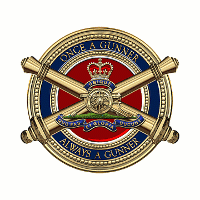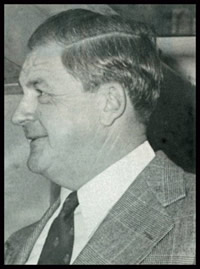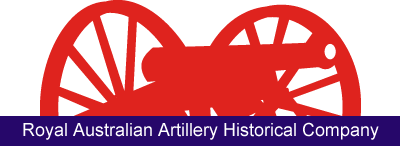| |
|
|
|
|
| |
|
|
|
|
| |
|
|
|
|
| |
|
AUSTRALIAN GUNNER
OBITUARY RESOURCE
|
|
|
| |
|
|
|
|
| |
|
|
|
|
| |
| |
| |
|
 |
|
|
| |
| |
Colonel JH Humphrey
25 September1928─5 August 2016 |
|
|
| |
|
|
|
| |
|
Colonel Arthur Burke OAM (Retd)
|
|
| Printed Version |
|
|
|
|
| |
|
|
|
|
 |
|
Gentleman John Humphrey deployed to his final posting in the Great Gun Park Up Above on Friday 5 August 2016. His loving family surrounded him as he peacefully slipped away and the Royal Regiment of Australian Artillery is the poorer for this passing.
John Henry Humphrey was born to British migrants at Paddington NSW on 25 September 1928. He was educated at the nearby Sydney Technical State High School, graduating in 1947. There was a strong family background in defence service and John determined to follow tradition by entering the Royal Military College Duntroon (RMC) in 1948.
Academically and technically proficient and a good sportsman, Staff Cadet Humphrey graduated near the top of his class in 1951. The good friendships he developed whilst at ‘Clink’ lasted the rest of his life—classmates included Paramor, Grey, Hockney, Burnard, Maizey, Kelly, Hooper, Khan and James.
Passing through 1st Recruit Training Battalion and 1st Reinforcement Holding Unit in Japan, Lieutenant Humphrey joined the 3rd Battalion Royal Australian Regiment in Korea on 4 July 1952. He was allotted as 4th Platoon commander, B Company commanded by Captain RP (Rupert) Richardson. The also newly arrived commanding officer, Lieutenant Colonel RL (Ron) Hughes would become John’s close friend later in life.
|
In mid-August, B Company carried out a night raid onto an enemy position on Hill 75 under covering fire from tanks, machine guns, mortars and artillery. At least 12 Chinese were killed and one taken prisoner. The Australians lost one killed, 24 wounded and two missing. Lieutenant John Humphrey was wounded while leading his platoon but remained in action and was Mentioned in Despatches. This overseas tour of duty concluded with three months as a Grade 3 Operations and Staff Duties temporary captain on Headquarters British Commonwealth Forces Korea. Returning to Australia in February 1954, Lieutenant Humphrey was posted to B (Anti-Aircraft) Battery of 1st Field Regiment at North Head. There he converted from Infantryman to Gunner and learnt the intricacies of air defence. This fitted him for temporary captain again and the appointment of adjutant 34th Heavy Anti-Aircraft Regiment at Holsworthy.
 |
|
With stability in his life again, John married his fiancée, the attractive Olwen Evans in March 1954. They made a striking couple, Olwen with her flowing brunette locks and John with his dark ‘flat top’—the style of the American tennis players of this era. Captain Humphrey remained with anti- aircraft for almost three years before being appointed adjutant of 1st Field Regiment which had just moved to Holsworthy. This was quite a change of Gunner diet for John as the unit had recently converted to two batteries of American field howitzers and one light battery of mortars.
Nevertheless, with his now well established expertise in staff duties and administration, he quickly came to grips with this new challenge. Humphrey was selected to attend the Australian Staff College in 1959 and John, Olwen and children John, Helen and Bronwen, moved to Queenscliff, Victoria. After Staff College came an operations staff appointment at Headquarters 1st Infantry Brigade Group before John was promoted major and appointed battery commander at Holsworthy of the independent 111th Light Anti-Aircraft Battery which sported the new power operated Bristol-Bofors guns and American Studebaker trucks. In September 1960, Olwen gave birth to the fourth Humphrey child, Christopher. Next came a most pleasant surprise—John was selected to attend the Long Field Gunnery Staff Course at the Royal School of Artillery, Larkhill, England. This was an accompanied posting, so the whole family packed up and moved to England in early 1962.
|
It had been quite some time since Major Humphrey had dabbled in field gunnery, but he revelled in the challenge and acquitted himself well on the course. Afterwards John had a six-month attachment in Colchester and then joined Headquarters Royal Artillery 1st Division at Verden an der Aller, Germany.
All good things must come to an end and in November 1963 the family returned to Australia where John was posted as a staff officer in the Directorate of Artillery, Canberra. This was a busy equipment oriented appointment as the RAA was looking for its next generation of field guns to replace the old 25 Pounders, locating was becoming more Regular soldier manned and air defence was investigating missile purchases. |
|
Just over three years later in August 1966, John was rewarded with promotion and appointed commanding officer of the Joint Tropic Trials Unit (JTTU) at Cowley Beach in north Queensland. This was a unique challenge for Lieutenant Colonel Humphrey and his technical and practical field experience was tried and tested with the many equipment research problems encountered. But all too soon the king and his kingdom were separated—John was posted to the directing staff at the Australian Staff College, Queenscliff. Being on the staff was less intensive than John’s previous time as a student and he slipped comfortably into work, the social life and had some time to enjoy his passion for golf.
In December 1970, John was appointed commanding officer of 1st Field Regiment and issued the challenge of preparing it for active service in Vietnam. It was a real ‘start from scratch’ and would be manned by about 70 percent National Servicemen. However, Lieutenant Colonel Humphrey had a nucleus of good and experienced officers to help— Majors IGA (Iain) Macinnis, MR (Mick) Hawkins and Captains GC (Gerry) Davies, JR (Jim) Jauncey and KBJ (Kerry) Mellor. One of his battery commanders at that time, Mick Hawkins had what he called a ‘special relationship’ with his CO, having been a troop commander when John commanded the 111th. He reminisced, ‘He was one of those rare people who demonstrated total loyalty up, down and sideways. John may be gone, but he lives on in the good aspects of those he mentored and motivated, and I am lucky to be one of them.’
By November 1972, Humphrey was satisfied that he had a good unit ready for service in Vietnam next year. Then came the federal election on 2 December when the Liberals were tipped out of office by Labor, National Service ceased, Australian service personnel were brought home from Vietnam and virtually 70 percent of 1st Field Regiment marched out. Lieutenant Colonel Humphrey’s chance to command an RAA unit on active service was not to be.
| |
 |
|
John was given a ‘Special Duties’ job at Headquarters Northern Command for ten months till the post Vietnam reorganisation of the Army settled, then posted to the new Headquarters Logistic Command in Melbourne. Rather than break up the family during vital years of the children’s education, John went to Melbourne unaccompanied. This proved to be a wise decision because 12 months later, Lieutenant Colonel Humphrey was posted back to Brisbane into the fledgling Headquarters Royal Australian Artillery (HQ RAA) 1st Division. An added bonus was the fact that the commander of 1st Division was Major General RL (Ron) Hughes CBE DSO, John’s old commanding officer from his Korea days.
Re-raising HQ RAA included taking technical control of the three Regular field artillery units. John was supported by Divisional Instructor in Gunnery Captain AR (Arthur) Burke, Divisional Artillery Sergeant Major WO1 TP (Tom) Banfield and a bombardier clerk. It was a strong team who developed and introduced training evaluation objectives, and re-raised a quasi HQ RAA 1st Division for exercise purposes. John would often ‘disappear’ during the day for an hour at a time. After a while, his staff twigged that he would be reminiscing with the General about Hill 75 in Korea and refighting their old battles. No one really minded as John always came back to his office beaming and full of bonhomie.
When former RAA officer Colonel HJC (Craig) Beck passed away in Canberra, the senior RAA officers’ deck chairs were hastily rearranged. John was promoted colonel and appointed the Director of Artillery (DArty) in Canberra. Colonel Humphrey revelled in walking the ‘corridors of power’ but still having the freedom to visit units all over Australia. When a recent RMC graduate, Lieutenant VH (Vince) Williams was sent to Mascot Airport to collect the visiting new Director, he recalled, ‘I hadn’t a clue what he looked like but fortunately it was raining. While all the other passengers scurried off the plane, one gentleman dressed in a tweed jacket, tie and grey flannels, walked calmly to the terminal, ignoring the downpour. “This had to be DArty,” I thought—and it was. A delightful gentleman.’
But despite all this, John and Olwen’s hearts were in Brisbane with their children, the warmer climate and the relaxed lifestyle. After two and one half years as DArty, John refused an overseas posting and decided it was time to hang up his spurs. He discharged on 12 March 1979 after 31 years dedicated, professional and meritorious service and retired to the family home in Ascot, Brisbane.
In retirement, John and Olwen enjoyed their membership at the Royal Queensland Golf Club as they entered their twilight years. John had always been keen on history and now had the opportunity to write a book on service in Korea—an unpublished manuscript which gave the family a true insight into his earlier life as a soldier. He became a life subscriber of the RAA Association of Queensland, regularly attended the Olds and Bolds Gunner Luncheons at Victoria Barracks and was one of the foundation members of the annual United States Marine Corps (USMC) Birthday Luncheons at the Brisbane Club.
 |
|
From my personal point of view, John and I began a very close friendship during our time at HQ RAA 1st Division. It was from him that I developed a passion for military history which I am still enjoying. When I was appointed Colonel Commandant RAA for Queensland in 2003, John was one of my wise confidants whenever I had a thorny problem. His sage advice was always just so correct.
Early retirement enabled John to be a loving and attentive grandpa to his five grandchildren and he embraced email in its early stages with a Hotmail handle ‘cybergrandpa’. When the family house at Ascot
became too big for just the two of them, John and Olwen built a smaller home on the property they owned next door.
Sadly, three years ago following successful open heart surgery, John suffered a major stroke from which he was not expected to survive. In his inimitable fashion though, he surprised the medical experts by not just beating the odds, but determinedly recovering sufficiently to move back home and live independently for a further 14 months. After another health episode in 2014 he and Olwen moved to an aged care residence in Yeronga on the south side of Brisbane.
|
On Thursday 4 August 2016, I heard that John was fading and had been admitted to St Andrews War Memorial Hospital in Brisbane and went to visit him the next day. Alas, I was too late to say ‘goodbye’ to my old mate. He has passed away with his loving family around him at 3.45am on Friday 5 August. As was his wish, he was farewelled by just a small congregation of family and close friends at the Albany Creek Crematorium on 9 August. A bugler from the RAA Band of his 1st Regiment RAA sounded a note-perfect Last Post and Rouse to farewell this old warrior.John Humphrey was one of nature’s gentlemen Gunners. He was softly spoken, provided wise counsel from his vast experience and, to my knowledge, never had a bad word about anybody—he could always find a positive in even the most annoying individual. He was technically proficient, professionally astute, and successfully guided many RAA personnel through bumpy patches in their careers. I am proud to say that he was one of my mentors.
|
 |
|
| |
Vale Colonel John Henry Humphrey—Korea veteran, distinguished Gunner and most of all an officer and gentleman of the highest order. Retired to the Great Gun Park Up Above at almost 88 years of age |
|
|
| |
| |
| |
|
|
|
| |
|
|
|
|
|


